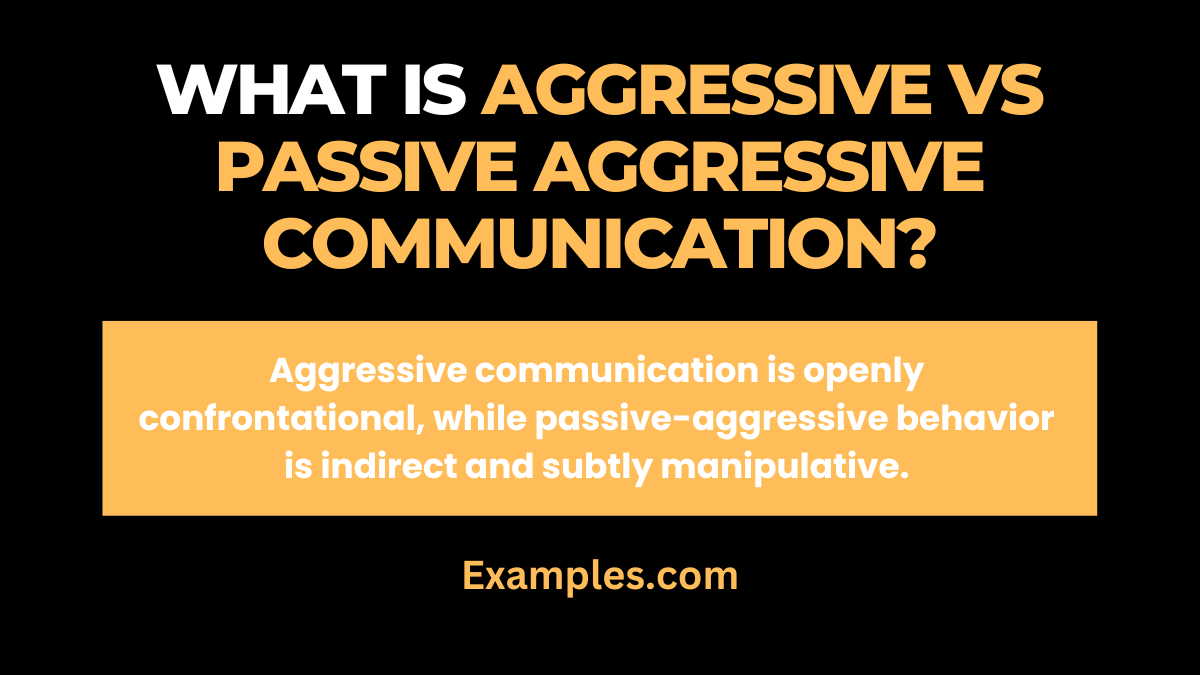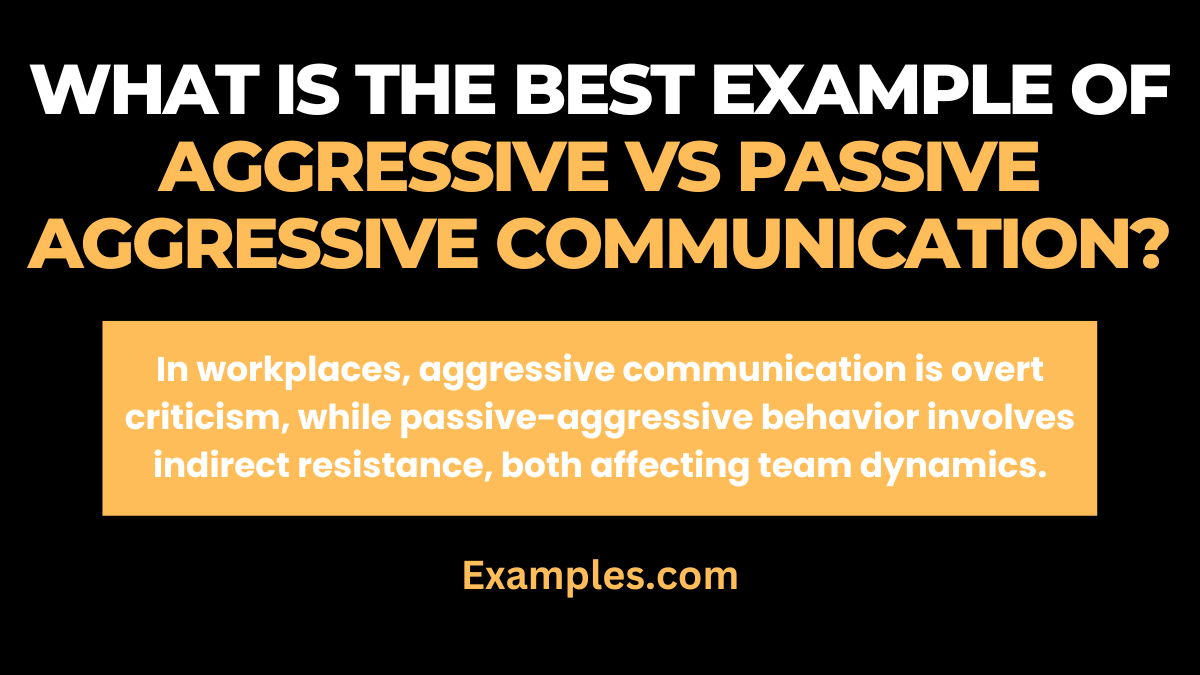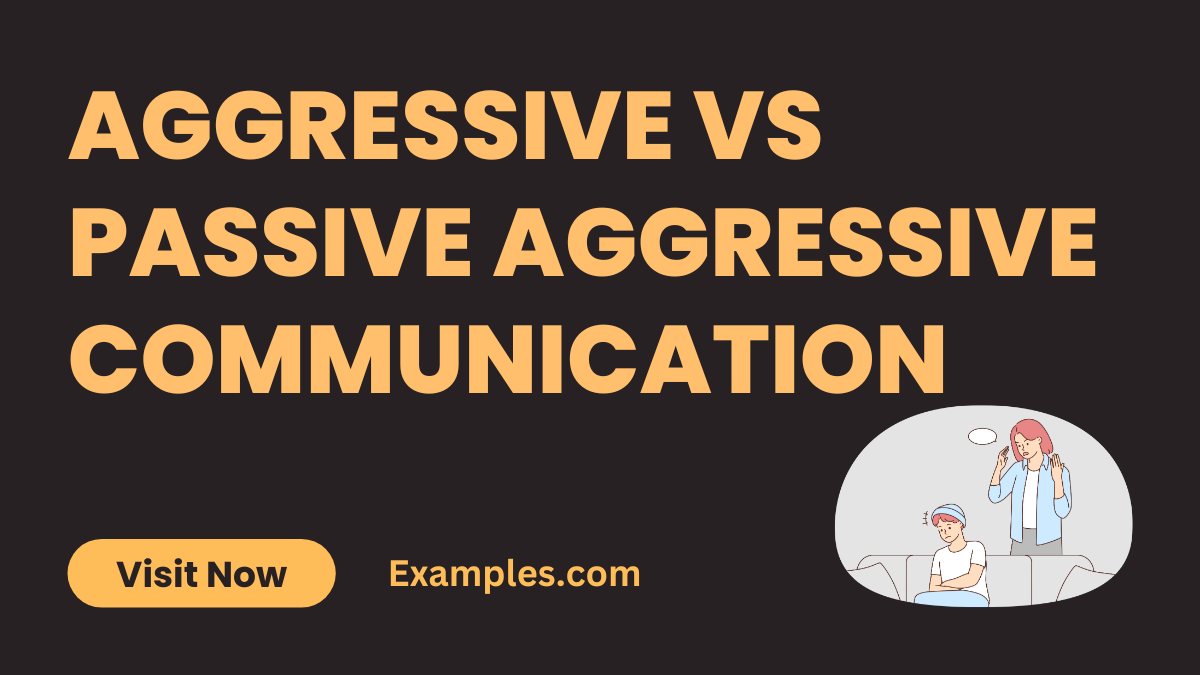Aggressive vs Passive Aggressive Communication – 19+ Examples
Understanding the dynamics of aggressive vs passive-aggressive communication is crucial in oral communication. Aggressive communication often involves direct confrontation, intimidation, and verbal attacks, reflecting a forthright yet often disrespectful approach. In contrast, passive-aggressive communication is characterized by sarcasm, mockery, and indirect expressions of hostility. Recognizing these styles helps in addressing and modifying communication patterns for more effective and respectful interactions, whether in personal relationships or professional settings.
What is Aggressive vs Passive Aggressive Communication?

Aggressive vs passive-aggressive communication represents two contrasting styles. Aggressive communication is direct and confrontational, often involving shouting, demanding, and blaming. It tends to be overtly hostile and can include impatience, interruption, and overbearing behavior. On the other hand, passive-aggressive communication is indirect and manipulative, characterized by subtle sarcasm, veiled threats, and hidden resentment. It often manifests as an avoidance of direct confrontation, using indirect methods to express displeasure or disagreement.
What is the Best Example of Aggressive vs Passive Aggressive Communication?

A prime example of aggressive vs passive-aggressive communication can be seen in workplace settings. Aggressive communication might involve a manager openly criticizing an employee in a meeting, using a loud tone and direct accusations. Conversely, passive-aggressive communication could be an employee agreeing to a task but then subtly undermining it through delays or sarcasm. Understanding these dynamics is key to recognizing and addressing such behaviors for healthier and more productive interactions.
Difference Between Aggressive and Passive Aggressive Communication

Aggressive communication is characterized by a direct, often confrontational approach, marked by verbal attacks, intimidation tactics, and overbearing behavior. It typically involves hostile body language and dismissive attitudes. In contrast, passive-aggressive communication is more indirect and manipulative, involving tactics like sarcasm, mockery, and subtle blame. While the former is overtly confrontational, the latter conveys discontent or disagreement in a covert, often underhanded way.
| Aspect | Aggressive Communication | Passive Aggressive Communication |
|---|---|---|
| Definition | Direct, often confrontational communication, marked by hostility and dominance. | Indirect, covert communication characterized by subtle manipulation and sarcasm. |
| Expression Style | Open and direct, often with raised voices like shouting or yelling. | Subtle and indirect, using sarcasm and insinuations. |
| Body Language | Hostile, such as pointing fingers or invading personal space. | Subdued but dismissive, like eye-rolling or smirking. |
| Emotional Tone | Typically angry, impatient, and intolerant. | Often resentful, sullen, or mockingly polite. |
| Conflict Approach | Direct confrontation, sometimes escalating to verbal abuse. | Avoids open conflict, resorts to manipulation or silent treatment. |
| Impact on Relationships | Creates fear or resentment, damaging trust. | Causes confusion and misunderstanding, eroding trust. |
| Resolution Tendency | Pushes for immediate resolution, often through demanding or commanding. | Avoids direct resolution, may use blaming or criticizing indirectly. |
| Common Scenarios | Aggressive bosses in the workplace, demanding in communication. | Sarcasm in response to requests, indirect blaming in team settings. |
10 Examples of Aggressive Communication
Aggressive communication is characterized by a direct, often confrontational approach that can undermine interpersonal relationships and workplace harmony. This communication style typically involves verbal attacks, intimidation tactics, and an overbearing demeanor, reflecting impatience, hostility, and a lack of empathy. Understanding examples of aggressive communication is crucial for identifying and addressing these unproductive patterns. These examples illustrate how aggressive communication manifests in various contexts, highlighting the need for more constructive and empathetic communication strategies.
- Direct Confrontation: “You’re wrong, and here’s why!” Asserting opinions forcefully without considering others’ perspectives.
- Verbal Attacks: “That was a stupid mistake!” Criticizing others harshly and disrespectfully.
- Intimidation Tactics: “Do it my way, or there will be consequences!” Using threats to enforce compliance.
- Manipulation: “If you were competent, you would have finished this already.” Imposing guilt to control others’ actions.
- Impatience and Interruption: “Stop talking; I know better!” Interrupting others and dismissing their input.
- Sarcasm and Mockery: “Oh, great job, as always!” Using sarcasm to belittle someone’s efforts.
- Blame and Accusation: “This is all your fault!” Assigning blame without considering the full context.
- Overbearing Behavior: “I don’t care what you think. This is how it’s going to be.” Disregarding others’ opinions and imposing one’s own.
- Hostile Body Language: Standing too close or pointing fingers to intimidate.
- Dismissive Attitude: “Whatever you say doesn’t matter.” Ignoring or trivializing others’ thoughts or feelings.
10 Examples of Passive Aggressive Communication
Passive-aggressive communication often masks underlying frustration or anger through indirect expressions. This style of communication is characterized by sarcasm, mockery, and subtle jabs, rather than direct confrontation. It can manifest in various forms, such as backhanded compliments, subtle digs, non-verbal cues, or deliberately procrastinating tasks. Understanding these examples is crucial in identifying passive-aggressive behavior, whether in personal relationships, the workplace, or other social interactions, and addressing them effectively to maintain healthy communication dynamics.
- Sarcastic Compliment: “Nice to see you finally made it on time.” Implies criticism over punctuality issues.
- Backhanded Compliment: “I’m surprised you did so well; I didn’t expect that from you.” Undermines the person’s achievement.
- Silent Treatment: Ignoring someone as a form of punishment.
- Procrastination: Deliberately delaying tasks to annoy or resist authority.
- Sighs and Eye Rolls: Non-verbal expressions of contempt or disapproval.
- ‘Forgetting’ Tasks: Intentionally neglecting responsibilities to express dissatisfaction.
- Ambiguous Comments: “Whatever you think is best.” Indicates disapproval without direct confrontation.
- Undermining Remarks: “Well, at least you tried.” Suggests failure despite efforts.
- Neglecting Messages: Intentionally ignoring emails or texts to convey displeasure.
- Fake Agreement: Saying “yes” while clearly meaning “no,” to avoid direct disagreement.
Comparison Between Aggressive and Passive Aggressive Communication
Aggressive and passive-aggressive communication styles differ significantly in how individuals express themselves and handle conflicts. Aggressive communication often involves direct confrontation, verbal attacks, and overbearing behavior, characterized by hostility and dominance. In contrast, passive-aggressive communication is indirect and manipulative, marked by sarcasm, mockery, and a dismissive attitude. Understanding these differences is crucial for effective interpersonal communication, especially in managing relationships and workplace dynamics.
- Expression: Aggressive communication is direct and confrontational, while passive-aggressive communication is indirect and subtle.
- Conflict Resolution: Aggressive communicators tend to engage in direct confrontation, whereas passive-aggressive individuals avoid direct conflict.
- Emotional Expression: Aggression is often expressed openly in aggressive communication, while passive-aggressive communication masks true feelings.
- Body Language: Hostile body language is common in aggressive communication, compared to the more subdued cues in passive-aggressive communication.
- Intention: Aggressive communication aims to dominate, while passive-aggressive communication often seeks to manipulate or control indirectly.
- Impact on Relationships: Both styles can strain relationships, but aggressive communication may lead to more open conflicts.
- Response to Stress: Aggressive communicators respond with impatience and intimidation, whereas passive-aggressive communicators use sarcasm and blame.
- Common Examples: Shouting and demanding characterize aggressive communication, while sarcasm and blaming are typical of passive-aggressive communication.
Relationship Between Aggressive and Passive Aggressive Communication
The relationship between aggressive and passive-aggressive communication lies in their shared foundation of unresolved conflicts and unexpressed emotions. Both styles stem from an inability to communicate needs and feelings healthily. Aggressive communication often results from a desire to assert control openly, while passive-aggressive behavior arises from a fear of direct confrontation. Understanding this relationship helps in identifying and addressing these unproductive communication patterns, crucial for healthy interpersonal relationships and workplace environments.
- Origin: Both stem from unaddressed emotional issues or conflicts.
- Control: Each style seeks control, with aggression being direct and passive-aggression being indirect.
- Emotional Impact: Both can cause emotional distress and misunderstanding in relationships.
- Communication Breakdown: Neither style fosters healthy, open communication.
- Conflict Avoidance: Passive-aggression avoids direct conflict, unlike open aggression.
- Manipulation: Passive-aggressive communication manipulates, whereas aggressive communication often intimidates.
- Resolution Difficulty: Resolving issues can be challenging due to indirectness or hostility.
- Need for Change: Recognizing and modifying these communication styles is essential for effective interaction.
Understanding the dynamics of aggressive and passive-aggressive communication is crucial for healthy interactions. This guide has equipped you with valuable insights and practical tips to navigate these challenging styles effectively. By choosing assertive and respectful communication, you can build stronger relationships, resolve conflicts constructively, and promote open and honest dialogues in both personal and professional settings.



